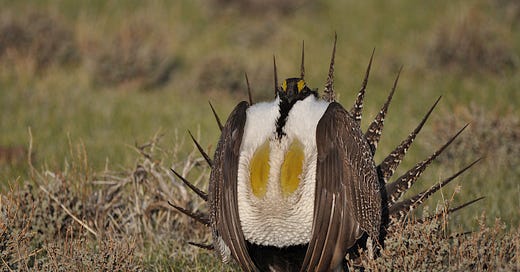News of the week
Green energy from the Salton Sea; trouble for the Hawaiian honeycreeper; restored protections for the sage-grouse
The Salton Sea
More than 30 percent saltier than the oceans, the Salton Sea lays in the midst of one of the driest deserts on Earth. It is big, 343 square miles, one of the 20 biggest lakes in the United States, yet it has only been in existence for a little over 100 years, the product of a canal breach and the excess waters from farmers irrigating their fields.
I’m fascinated by the Salton Sea. It is less than a three hour drive from where I live. But I’ve never been there.
The Salton sea was once touted as a luxury get-away to rival Palm Springs, but the incongruities of its existence has led to a dubious ecological niche. I guess the promise of the stench of another fish die-off has kept me away.
But the Salton Sea may prove crucial to transitioning to green energy
The Salton Sea and surrounding area are geothermally active, enough so that at least 11 geothermal plants have been established in the region.
In November, The Department of Energy and the US Geological Survey announced the GeoFlight: Salton Trough Initiative. Using low-flying aircraft equipped with instruments that measure variabilities in magnetic and radiometric characteristics of the landscape, the governmental agencies hope to find signatures of hotspots in the Earth, hotspots that can be commercially exploited to add even more generating stations to the power grid.
The combination of being geothermally active and having salty water also makes the Salton Sea area a prime place to mine lithium, one of the essentials needed to make lithium-ion batteries. An Australian company has recently embarked on a $500 million project to extract lithium from brine pumped thousands of feet up from a geothermally active aquifer near the Salton Sea. If the project is successful, many other such lithium mining operations will certainly pop up around the Salton Sea.
Steep decline in the number of Hawaiian honeycreepers
Big hat tip to Matt Gill, one of the biggest bird enthusiasts I know, for sending this story off to me.
The critically endangered Hawaiian honeycreeper ‘Akikiki is skirting extinction. Found only on in mountain rainforests of Kauai, habitat loss, a hurricane in 1992, and mosquito-borne avian malaria have decimated the ‘Akikiki’s population. Fifty years ago, these birds numbered more than 6,800 individuals. Today, the total population of the honeycreeper may have dipped below 50. There are just two places on Kauai where the bird can be found, and this last year, one of those places lost nearly all of its birds.
Biologists blame climate change, which has warmed the mountains of Kauai enough for mosquitos to migrate to the ‘Akikiki’s habitat. Without control of mosquitos, which pass the malarial microorganisms to the birds, the Hawaiian honeycreeper could be extinct within two years. Government agencies have a program to introduce sterile mosquitos into the wild as a means of controlling the disease, but funding might be a problem. The San Diego Zoo Wildlife Alliance is taking part in the extreme conservation efforts for the bird. (Bird Watching Daily)
Conservation plan for the sage-grouse under review
At the end of November, the Bureau of Land Management announced that it was opening up a comment period for the greater sage-grouse conservation plan.
The Interior Department, under Donald Trump, opened up millions of acres of sage-grouse habitat for mining companies in 2017. Earlier this year, however, a judge blocked the Trump administration’s move when a group of environmental organizations sued to protect the sage-grouse. In his ruling, judge B. Lynn Winmill called the action of the Trump administration “arbitrary and capricious.” Trump’s actions were a reversal of a 2015 Obama administration plan to protect the sage-grouse.
Earlier this year, the BLM announced that it was reinstating the plans laid out in 2015.
Sage-grouse are ground-dwelling birds that grow about two feet tall, with mottled, brown and black plumage and an array of pointy tail feathers. Males are a bit bigger than females and have a white ruff around their necks. They eat plants, mostly sage, and insects.
They inhabit sagebrush dominated landscapes from western North Dakota, Wyoming, and Colorado, west into Washington, Oregon, and northeast California. Scientists estimate that there were once millions of sage-grouse, but their numbers have been greatly reduced, with their population estimated to be between 200,000 and 500,000. Although protections have been reinstated, sage-grouse continue to be threatened by mining, electricity generation (Yes, including those giant windmills), pipelines, roads, transmission towers, fences, conversion of land to agriculture, more frequent and fiercer fires, poorly managed cattle grazing, climate change, and that scourge of the West we all hate, invasive cheatgrass.
For more environmental news follow me on Twitter @EcoScripsit.





